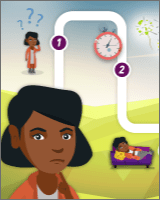Find out what to expect when you start LEMTRADA treatment for relapsing MS

MY EXPERIENCE WITH SIDE EFFECTS
By Rachel, Wife, Mother, Domestic Engineer
Here’s some insider advice: keep a journal of some sort to document your entire infusion experience. It’s a great way to keep track of how you’re feeling and any infusion-related side effects that you may have. I kept a journal and found it was super helpful to keep track of my experience. It was also a useful way to document when and what medications I took—which also made it easy for me to recall for my personal use and report it to my team of healthcare providers, so we could maintain good communication.
Even though my healthcare team had thoroughly prepared me and explained potential infusion-related side effects and long-term side effects, this was all uncharted territory for me. I was equally scared and excited about my first round of infusions.
I started off by taking the premedication that my doctor recommended, but apart from getting an IV placed into my arm, I had zero discomfort for the first 2 days. On day 3, however, I began to experience hives and I also got a rash on my chest and face—but those things were treated with an increased dose of antihistamine. Those infusion-related side effects continued through day 5 of infusions and lasted a little bit into the weekend after. Eventually, the infusion reactions had run their course and I recovered from them.
For my second round of infusions, I took the premedication again. I had the same hives and rash on my chest and face. And again, the side effects were treated with an increased dose of antihistamine. Also, the infusion-related side effects didn’t last as long as they had the first time around, and I was able to recover from them more quickly.
Since my first treatment course of LEMTRADA, I’ve continued the required monthly monitoring to check for any possible long-term side effects from treatment and so far, all of my labs have come back as normal!
In my experience, the side effects I have had with LEMTRADA have all been infusion-related. Even though I haven’t personally experienced any other issues, I’m still mindful and I always watch for other long-term side effects, such as signs of autoimmune problems.
I really appreciate the monthly monitoring. It’s good to know someone is looking after me.
-
 SEE MORE ARTICLES
SEE MORE ARTICLES
-
 MONTHLY MONITORING WITH LEMTRADALEMTRADA patient Donnie discusses how he made monthly monitoring a... LEMTRADA patient Donnie discusses how he made...
MONTHLY MONITORING WITH LEMTRADALEMTRADA patient Donnie discusses how he made monthly monitoring a... LEMTRADA patient Donnie discusses how he made... -
 MY EXPERIENCE WITH SIDE EFFECTSEven though my healthcare team had thoroughly prepared me and explained... Even though my healthcare team had thoroughly...
MY EXPERIENCE WITH SIDE EFFECTSEven though my healthcare team had thoroughly prepared me and explained... Even though my healthcare team had thoroughly... -
 My LEMTRADA infusion-day experiencesSince I have personal experience with LEMTRADA infusions, I’ll fill you in on... Since I have personal experience with LEMTRADA...
My LEMTRADA infusion-day experiencesSince I have personal experience with LEMTRADA infusions, I’ll fill you in on... Since I have personal experience with LEMTRADA... -
 Taking It Slowly: Be Mindful of Post-Infusion FatigueWhy is it so important to understand how to take care of yourself after your... Why is it so important to understand how to...
Taking It Slowly: Be Mindful of Post-Infusion FatigueWhy is it so important to understand how to take care of yourself after your... Why is it so important to understand how to...


